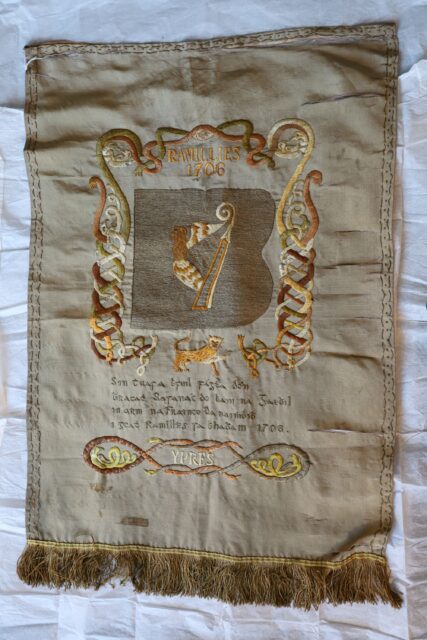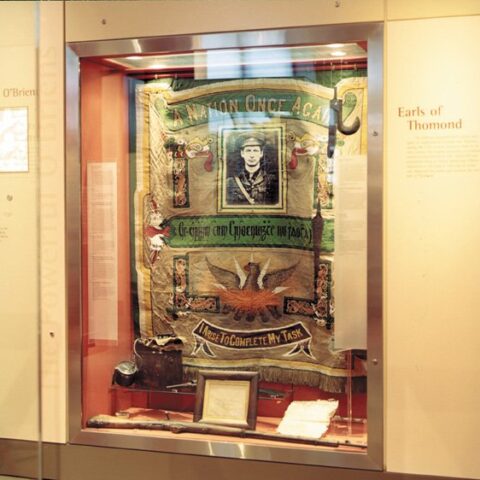The French Connection
Following the signing of the Treaty of Limerick in 1691 at the end of the Williamite Wars, there followed an exodus of many thousands of young Irishmen to fight in armies of the Catholic Kings of Europe. They were known in Ireland as ‘The Wild Geese’. So many Irishmen joined the French military, they formed their own Irish Brigade. One of the regiments in the brigade was the Clare Dragoons and made up largely of Claremen and commanded by an O’Brien.
In May 1706, during the War of Spanish Succession, the Army of the Grand Alliance of England, Austria and the Dutch Republic, defeated the Bourbon army of France, Spain and Bavaria at the Battle of Ramillies in Belgium. The only victorious action the French had that day came at the hands of the Clare Dragoons who captured the colours of the British commander, the Duke of Marlborough, John Churchill.
Although most of the fighting that led to the victory for the Grand Alliance was carried out by Dutch troops, the Battle of Ramillies is considered by the British to be among their greatest victories on the field of battle and it greatly enhanced the reputation of the Duke of Marlborough, who was an ancestor of Winston Churchill. The battle is also listed among the honours of many British regiments.
It took about three weeks for news of the Battle to reach the people of Clare. This was a period in Irish history that was dominated by anti-Catholic Penal Laws, and so there was great pride that Clare came out of the battle with honour, especially as the British were crowing so much about the victory.
At Ypres in Belgium, not far from Ramillies, there was a convent of Irish Benedictine nun’s and it was here that the captured banner was taken and presented to the Irish congregation by the Clare Dragoons.
The exploits of the Irish Brigade in Europe and of their battles in Cremona, Casano and Ramillies continued to resonate in Ireland during the 19th century. Thomas Davis, the Irish nationalist writer, penned the song ‘The Flower of Finae’ which told a romantic story set at the time of the Battle of Ramillies. For one verse he wrote:
At a cloister in Ypres a banner is swaying
And by it a pale, weeping maiden is praying,
The flag the sole trophy of Ramillies’ fray,
The nun is poor Eileen, the flower of Finae
The influence of the First World War, sport and Irish nationalism
Is the Ramillies banner the source of the name, then? It could be. Following the outbreak of the First World War in August 1914, the Ypres Banner soon came to prominence once again.
The First Battle of Ypres began on the same October weekend as the Clare Hurling team won their first All-Ireland hurling title and at a time when nuns of the Benedictine convent were evacuated to Ireland ahead of the battle. The association of Clare with Ypres and the captured banner was quickly exploited to recruit Claremen for the British Army – a recruitment banner making that connection is in the museum collection.

A small banner that used the valour of Claremen fighting for France in the Battle of Ramillies in Flanders in 1706 as a recruitment tool for Claremen to join the British army and fight at Ypres, Flanders in 1914-1915.
The Gaelic Athletic Association – the GAA – with its intercounty Football and Hurling Championships has played a significant role in creating county identities in Ireland. It seems reasonable to assume that the combination of the story of the banner being given prominence at the start of the First World War, its use as a recruiting tool and the Clare Hurling teams All-Ireland title led to the emergence of ‘The Banner County’ for Clare.

Hanging in the back of a showcase is a banner featuring a photo of Eamon de Valera. It was paraded around Clare during the East Clare by-election in 1917.
In July 1917 Eamon de Valera stood for Sinn Féin in the East Clare by-election, and a banner with his photograph at the centre was paraded around Ennis ahead of his historic victory.
Clare’s association with ‘the Banner’ was firmly established by the second decade of the 20th century.
